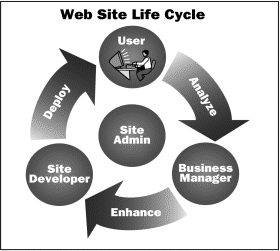
Microsoft Corporation
Microsoft® Site Server makes it easy for organizations to enhance, deploy, and manage sophisticated intranet and Internet Web sites. As Web sites evolve to support business-critical applications, companies are looking for solutions that minimize the complexity of managing intranet, Internet, and commerce-enabled sites. Whether you are deploying a new site or enhancing an existing one, Microsoft Site Server provides a comprehensive Web life-cycle solution focused on maximizing the return on your Web-site investment.
Introduction
Goals for Business Intranet and Internet Sites
Life Cycle of a Business Web Site
Life Cycle Activities
Microsoft Site Server and the Web-Site Life Cycle
Summary
Businesses measure the successful implementation of technology by the impact on the bottom line. Return on investment is of the utmost importance, whether your business Web site is focused internally on employees or externally on customers or business partners. The return on investment equation for a business Web site has two main factors: the ability to increase the business value of the site, and effective management of the total cost of ownership.
Microsoft Site Server takes your Web environment to the next level by applying a best practice approach to addressing the challenges facing businesses today. As the newest member of the Microsoft BackOffice® family, Microsoft Site Server not only helps reduce your total cost of ownership, but more importantly, helps establish and increase the business value of your site. This powerful combination delivers the return on investment businesses are looking for from their intranet and Internet sites.
The World Wide Web promised a relatively easy way to publish information to a broad audience. This promise led to the explosive emergence of business Web sites. The response to this easy access to information has been dramatic. However, people are no longer satisfied with volumes of static information, they want to quickly locate the right information and act on it. Business logic and applications are also becoming an integral part of the business Web environment, and Internet commerce-enabled sites are becoming increasingly prevalent. As sites add these capabilities, their role within a company expands and they take on a mission-critical profile.
As intranet and Internet business sites have grown in sophistication, the costs have risen proportionately. The business-critical nature and complexity of sites has also increased the demands on business managers, site developers, and site administrators. Today, business sites are corporate assets that need to be managed, measured, and evolved to meet changing demands, and enhanced to take advantage of new business opportunities.
Business managers need to be able to quickly measure and analyze site usage and drive site enhancement to achieve the business goals of the site. Site developers must be able to rapidly build rich, dynamic, database-driven sites, personalize the user experience, and develop business- and commerce-enabled applications. The administrator must be able to quickly, easily, and securely stage and deploy the latest content while managing and troubleshooting the Web site environment.
This process defines the life cycle of an intranet or Internet business Web site. Until now, sites have had to build solutions from scratch or stitch together a collection of components to address these requirements. This is a time consuming and costly proposition. The companies who can most effectively address the challenges of managing the life cycle of their Web sites and who can continuously and strategically improve their sites will have a significant competitive advantage.

Figure 1. The life cycle of a business Web site
Microsoft Site Server provides a comprehensive solution for Web life-cycle management and makes it easy to enhance, deploy, and manage sophisticated intranet and Internet sites. Site Server is the newest product in the BackOffice family and is available in two editions: Microsoft Site Server and Microsoft Site Server, Enterprise Edition. The Enterprise Edition is the foundation for the creation of comprehensive commerce-enabled Web sites and provides features for in-depth analysis and advanced site management.
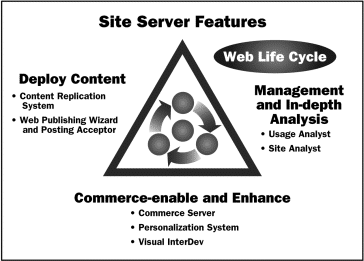
Figure 2. Microsoft Site Server features
Built on the foundation of the Microsoft Windows NT® Server operating system and Internet Information Server and taking advantage of the power of Microsoft BackOffice, Microsoft Site Server makes it possible to maximize your investment and achieve your intranet and Internet business Web-site goals.
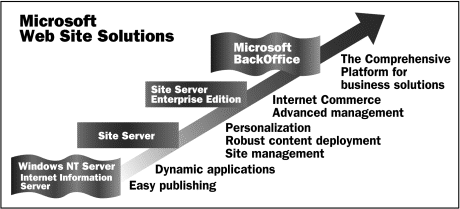
Figure 3. Web-site solutions
Intranet and Internet sites alike are focused on delivering the right information to the right people. Microsoft Site Server allows you to provide rich, dynamic content—either internally by employee group or job function, or externally by individual customers or business partners. Microsoft Site Server provides the capability to personalize and customize each site visitor's experience. The more the user visits the site, the better the user experience becomes. This creates a feedback loop that provides data for site analysis and enhancement.
As Web sites gain richer content and include more sophisticated applications, they become more costly and difficult to implement and maintain. Microsoft Site Server provides a reliable, secure and efficient way to stage, deploy, and replicate (Replication of content requires one or more additional Site Server licenses.) new content across your Web sites. Microsoft Site Server also simplifies the process of posting and publishing content to a Web server.
Sites have become corporate assets that need to be managed, analyzed, and continuously improved. Microsoft Site Server allows you to visualize your site environment. It gives you the tools to identify and troubleshoot the site structure both inside and outside of your firewall. Microsoft Site Server allows you to freely measure, analyze, and report on site activity. Site Server's usage analyst features enable you to track information such as number of user visits and length of stay. This trend and usage information allows you to enhance your site effectively and improve the user experience for targeted customers.
It is important to provide new capabilities without compromising your investment in existing Web sites, business applications, and data. Microsoft Site Server, in concert with Microsoft Windows NT Server and Internet Information Server, not only allows you to build powerful new Web sites, but can be added to existing Web environments and provide immediate value, regardless of your server mix. Sites Server is designed to let you take advantage of data that exists in your current business systems. For instance, commerce-enabled sites can be built by using product and pricing information that may currently exist in an inventory or merchandizing system. Usage Analyst import features allow you to combine general business data with Web site data for comparative analysis and reporting. For example, you can contrast Web sales data with order entry sales data for channel analysis.
Competition is driving the need to rapidly acquire new customers as well as retain existing customers. The Web is providing new and exciting ways to interact with the global market place, whether establishing a new direct-sales channel to your customers or building strong business-to-business sites to support your virtual enterprise. Microsoft Site Server, as the foundation for the Microsoft Internet Commerce Strategy, provides the platform to help you create, deploy, and manage rich, business-to-consumer and business-to-business Internet commerce sites.
Microsoft Site Server is a comprehensive business Web-site product based on continuous improvement.
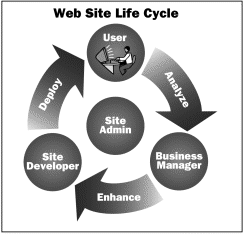
Figure 4. The life cycle of a business Web site
Whether you're creating a new site or enhancing an existing one, Microsoft Site Server enables the rapid development and reliable deployment of Web content, the delivery of personalized content, the ability to analyze usage patterns, and the management of site consistency and integrity. Microsoft Site Server enables an organization to continuously improve their site based on user behavior and changing business requirements.
If you have an existing Web presence or are creating a new Web site, you need to be able to quickly implement new ideas and technologies, measure their efficiency and business value, and respond accordingly. Enhancement, as the driving force in the Web-site life cycle, keeps Web-site activities focused on continuous improvement. This improvement not only includes the expansion of successful Web activities but the elimination of ineffective processes as well.
Web-site improvements may include personalizing the experience of your users, adding compelling content and powerful business applications to your site, or extending your site to include new capabilities such as Internet Commerce. Microsoft Site Server allows: the delivery of targeted content, the rapid creation of rich content and Web applications (facilitated by an integrated application development environment with powerful database tools), and extension of the site to sell goods and services or establish business-to-business applications over the Internet.
As business Web sites take on more mission-critical roles, currency, consistency, and accuracy become more important, and administration becomes more of an issue. The size and complexity of business Web-site environments is also increasing the need for a more structured and disciplined approach to deploying content and applications. Site administrators today need to implement processes to stage and test mission-critical content before global deployment. Site administrators are also looking for ways to reduce the total cost of maintaining, improving, and extending business sites. Whether you are responsible for a departmental site within a corporate intranet or you are the administrator for an Internet commerce site with very high transaction volumes, reliable, secure deployment of content and applications is key.
Site Server is designed to address the wide range of deployment requirements confronting administrators today. Site Server provides deployment solutions that scale from the easy wizard-based posting of content, to a single Web server, to a full content replication that automates the publishing, staging, and replication of content across a large Web-production environment.
As sites become more complex and content presentation becomes more personalized, site management and analysis tools are key to establishing and continuously improving quality business Web sites. The total cost of ownership for a business site can be reduced significantly by providing tools designed to reduce the time consumed in administration. Site Administrators need to visualize, troubleshoot, and report on site structure, measure the efficacy of the site, and actively manage Web content.
Business managers need to track, measure, and analyze the way users interact with their Web environment in order to define site enhancements. Usage analysis also provides a mechanism for determining if targeted messages are reaching the appropriate audience. Since Web sites are becoming a part of the general business-systems environment, Web-site information needs to be combined with business data for analysis and reporting.
Site Server provides comprehensive site visualization, content analysis, link management, and reporting capability for managing Web sites. The usage analysis features of Site Server support the in-depth exploration of Web-site data and form the foundation for site enhancement. General business data can be imported with Site Server for comparison reporting and analysis.
In a business Web site—whether intranet, Internet, or commerce-enabled—the user is the ultimate focus of all site activities. Without success at the user level, no business goal can be achieved. As the comprehensive life-cycle activities come together, several functional areas have emerged: business management of the site, site development, and site administration. These activities may be performed by one or more individuals, depending on the size and complexity of the intranet, Internet, or commerce-enabled site environment.
Business-site management defines the goals for the site and increases the business value of the site. This requires that site managers continuously improve their sites by measuring, analyzing and reporting on Web site–related data and applying the results to enhance their intranet or Internet site.
Site development involves building rich, dynamic content, and applications designed to improve the user experience and deliver the information necessary for analysis. Content and application development on the Web today includes not only programming but has strong creative aspects based in graphics and multimedia.
Site administration addresses the efficiency, reliability, and security of day-to-day site operations. Administrators are particularly interested in automated staging and deployment as well as site analysis and troubleshooting. Administration, along with the site development, is a major factor in the total-cost-of-ownership equation.
The Web today consists mainly of static Hypertext Markup Language (HTML) pages that deliver the same page to all users. Most content is neither targeted nor personalized for users who must navigate through a series of links to find what they need. Even if users expedite Web surfing by using bookmarks, the content is still generalized. The challenge for Web designers is to create sites that are relevant and compelling to users, while also maximizing the effectiveness of the sites by targeting the right content to the right people.
Microsoft Site Server offers personalization that allows Web designers to create dynamic and personalized Web sites. Personalization builds upon the Active Server Pages (ASP) feature in the Microsoft Internet Information Server to deliver dynamic Web sites. An ASP is an HTML page that contains server-side executable scripting, written in a variety of standard scripting languages such as Microsoft Visual Basic®, Scripting Edition (VBScript) and Microsoft JScript™. Dynamic Web sites using ASPs make the Web come alive by delivering active content that responds to user interaction and includes richer media types such as audio, animation, and video.
Personalized Web sites take this evolution one step further by delivering the right active content automatically to each user. The more the user visits the site, the better the experience gets. This creates a feedback loop that continually increases customer satisfaction. Personalizing your Web site is a three-step process:
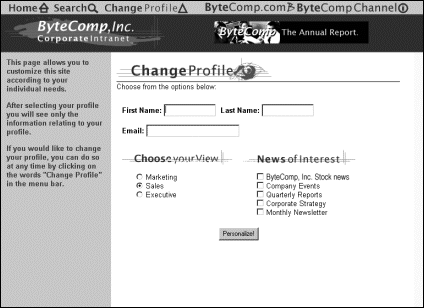
Figure 5. A personalization form
In the Web life cycle personalization plays a powerful role. Personalization delivers real data from the user/site experience, it is this data that forms the foundation for sophisticated usage analysis and site enhancement.
Site Server allows you to extend and enhance your site through the easy creation of dynamic Web applications. Included as a promotion, Visual InterDev is an integrated development system for building dynamic Web applications. It includes an integrated development environment, seamless connectivity to any open database connectivity–based (ODBC-based) databases, prebuilt components, wizards, and content-creation tools. Visual InterDev provides everything a developer needs to quickly develop and enhance Web sites for business critical applications.
Visual InterDev includes a comprehensive development environment that integrates all the tools necessary to build and deploy Web applications. The environment is designed to dramatically boost developer productivity by supporting multiple users working on the same project at the same time with source-control safety.
Active Server applications are based on Active Server Pages, a new feature of Microsoft Internet Information Server 3.0. As a server-side application framework, ASPs make it easy to build dynamic Web applications with sophisticated server-side processing such as database access, state management, server-side scripting, and reusable server components. Visual InterDev is the best way to build Active Server applications.
Visual InterDev offers the most complete and advanced database-development features available in any Web-development tool. Visual InterDev provides scalable Internet- and intranet-based access to any database that supports ODBC. This includes high-end database management systems such as Microsoft SQL Server™, Oracle, Sybase, Informix, and IBM DB/2, as well as desktop databases such as Microsoft Access and the Microsoft Visual FoxPro® database management system.
Visual InterDev is designed to support industry standards such as HTML, HTTP, ODBC, ActiveX™, COM, and Java. As such, it delivers a high degree of interoperability with other tools and platforms and provides for seamless extensibility through third-party components.
Capitalizing on the sale of goods and services over the Internet easily and cost-effectively is a topic of great interest to businesses. Microsoft Site Server can be used to create a high-impact site for your business to promote and sell to consumers or create business-to-business sites to support applications such as corporate purchasing. Microsoft Site Server also enables you to extend and enhance your site through the easy creation of dynamic Web applications and the delivery of personalized content and experiences.
The commerce capabilities within Microsoft Site Server extend the Windows NT and Internet Information Server platform with commerce-specific functionality. Microsoft Site Server includes more than 50 server components that provide the run-time environment for the development, operation, and presentation of online commerce sites.
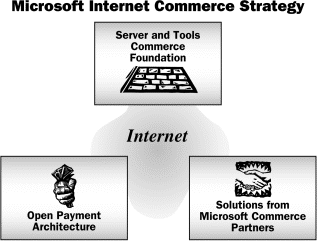
Figure 6. Microsoft Internet Commerce strategy
Microsoft Site Server provides customers with key commerce features and capabilities.
The Order Processing Pipeline (OPP) is a series of fourteen distinct stages that define the business rules of how orders are managed at the commerce site. Each stage contains a set of order processing components, or COM objects, that can be specified and configured to work with the unique requirements of the business. Leading Independent Software Vendors (ISVs) are writing components designed to work with the OPP. This ISV offering provides customers with the ability to more easily create custom sites without custom programming.
Site Server includes the Host Administrator, a graphical user interface (GUI) providing site managers with complete control over the opening, closing, and deletion of commerce sites. In addition, Site Server includes the Store Builder Wizard, an ASP-based application that provides a simple step-by-step approach to designing a basic commerce site. Site Server includes four Starter Stores (sample commerce sites) in full source form, designed to highlight the product capabilities. Site server also provides an ASP-based wizard to create a commerce site that can be further tailored using an HTML authoring tool. The Pipeline Configuration Editor and additional tools for use with new content are also included.
Commerce sites developed using Site Server can support any ODBC-compliant database as well as any database schema. This allows businesses to utilize their database investment such that existing product data does not have to be reformatted or reloaded into a new database to be used on the Web. In addition, new sites being developed with Microsoft Site Server have maximum flexibility in the design of new databases.
Microsoft Site Server includes Buy Now, an ActiveX control designed to commerce-enable any content. Buy Now can be run as an advertising banner on a third-party site to send orders back to a specific Order Processing Pipeline without forcing the user to leave the original Web page. In addition, Site Server includes a software development kit (SDK) for extending the Order Process Pipeline, integrating the Microsoft Wallet for use by your customers and adding new payment methods to the Microsoft Wallet. The Wallet consists of two ActiveX controls that facilitate address and payment selection that work with third-generation browsers such as Microsoft Internet Explorer 3.0 and Netscape Navigator 3.0, and a protected client storage area.
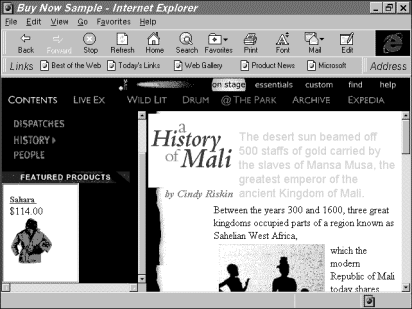
Figure 7. Buy Now
Site Server features a robust Web-content propagation engine that automatically replicates file-based content from one or more remote content servers to multiple-destination content servers. It is applicable in a variety of configurations, including production server staging, production server mirroring, and large and/or complex replication scenarios, and works securely and reliably through firewalls and across the Internet or any other navigable network.

Figure 8. Content Replication
Site Server supports a range of replication methods that enable companies to replicate partial or complete sets of content to one or more destination servers in a highly manageable and automated way. Site Server permits a replication to be "rolled back" so a server can be returned to a previous state, guarantees delivery of content to the destination server in the event of a failed transfer, supports transmission through corporate firewalls, and guards against unauthorized replication or hijacking of transmitted data. Site Server also provides a complete set of COM interfaces to support extension of the system and facilitates the notification of other applications when replication-system events occur.
An easy-to-use client wizard that allows all types of users to publish files and directories to the Web is included with Site Server, along with a Web Posting Acceptor. The Posting Acceptor feature is a Web server extension that allows Microsoft Internet Information Server to accept posts over HTTP (RFC1867) and optionally forward those files to the content replication features in Site Server, the file system, or any other secondary system.
The site analysis features of Site Server allow you to actively manage Web content, regardless of your mix of Web servers, and learn about how your site is being used. Microsoft Site Server enables you to visualize the layout of your site, measure the site's effectiveness, and continually improve user experiences.
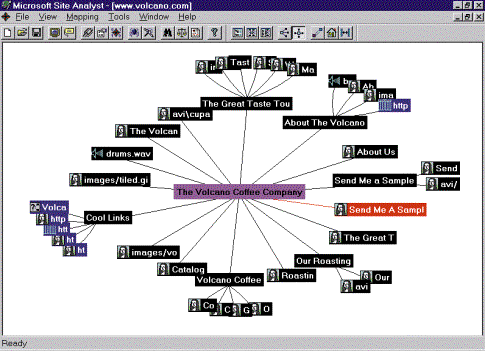
Figure 9. The Site Analyst
Site Server provides comprehensive site visualization, content analysis, link management, and reporting capabilities for managing Web sites. Easily visualize how your site is laid out, recognize repetitive content, and identify broken links. Site Analyst lets you create comprehensive HTML reports that detail site content and consistency. Site Analyst enables you to manage Web content efficiently and effectively in order to provide a positive user experience. Microsoft Site Analyst helps Web professionals manage their sites and solve problems with speed and efficiency through the automation of many common Web site management tasks.
With Site Server you can create and open a Web map of any site on your intranet or on the Internet. You can visualize your site structure and content with either the Tree view or the new Cyberbolic view. The Tree view displays the site's hierarchy while the Cyberbolic view lets you look at your site graphically. You can navigate around your site view by dragging your mouse and easily zoom in for details. This powerful tool makes it easy to monitor content and maintain site consistency and quality. Site Analyst creates a complete set of linked HTML reports for managing your Web site and provides the link analysis and custom search capabilities necessary to effectively and efficiently manage business intranet and Internet sites.
Microsoft Site Server usage analysis features support the in-depth exploration of your Web site usage data to maximize your return on Web investment. Site Server includes a ready-to-run reporting system and tools to develop custom-usage analysis reports. Import facilities are also provided to allow you to incorporate business systems data into your analysis for comparative and comprehensive reporting.
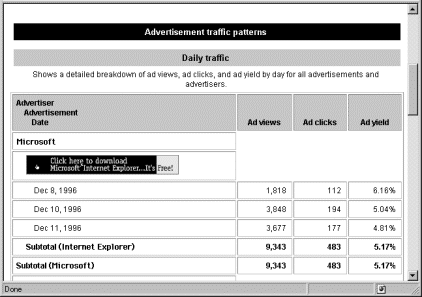
Figure 10. The Usage Analyst
Usage Analyst allows you to import Web server logs and provides a suite of summary detail and comprehensive usage-analysis reports to provide the appropriate level of information about your site activity to those who need it. The standard reports provide such information as request and visit trends, navigational patterns, and server-load patterns. Armed with this information, you can enhance your site and make the adjustments necessary to the site to better serve and target your customers. Site Server supports over 20 log file formats on Windows NT, UNIX, and Apple® Macintosh® operating systems, including those from Microsoft, Netscape, Apache, and O'Reilly.
Site Server enables the hierarchical configuration of log-data sources from multiple servers with any combination of content sites. This provides Enterprise class management to accurately analyze the most complex, multihomed or distributed-server environments.
Site Server allows you to aggregate data across multiple Internet or intranet servers and sites. You can cross reference and combine data from any combination of your sites to analyze user behavior throughout your content.
With Site Server, you can customize the database with any number of new dimensions, including content, time, user, and organization categories. For example, you can integrate user demographic and/or psychographic data collected from forms on your Web site to correlate what people say about themselves with what they actually check out on your site (that is, their navigation patterns).
You can create your own usage-analysis reports with Site Server to take advantage of multidimensional data reporting with any number of row dimensions, column dimensions, or measures per calculation. Site Server lets you analyze the data exactly as you would pose the question, which enables you to more effectively answer your site's most pressing questions.
Microsoft Site Server is a comprehensive Web site environment for the enhancement, deployment, and advanced management of intranet, Internet, and commerce-enabled sites. Microsoft Site Server utilizes the Microsoft Windows NT Server network operating system and Microsoft Internet Information Server.
For the latest information on Microsoft Site Server, check out the Microsoft Site Server Web site (http://www.microsoft.com/siteserver/).
The information contained in this document represents the current view of Microsoft Corporation on the issues discussed as of the date of publication. Because Microsoft must respond to changing market conditions, it should not be interpreted to be a commitment on the part of Microsoft, and Microsoft cannot guarantee the accuracy of any information presented after the date of publication.
This White Paper is for informational purposes only. MICROSOFT MAKES NO WARRANTIES, EXPRESS OR IMPLIED, IN THIS DOCUMENT.